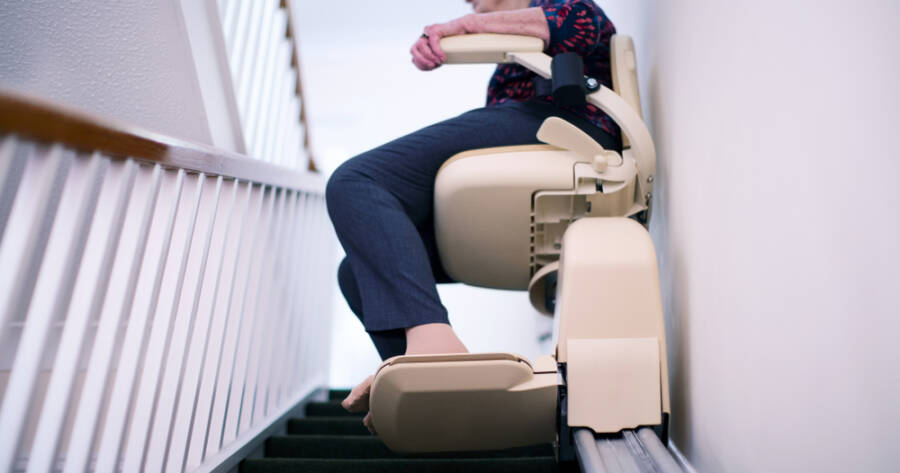For individuals with mobility challenges, navigating stairs can be a major obstacle. While stairlifts are a popular solution, they aren’t always the best fit for every home or budget. Fortunately, there are several alternatives that can provide similar benefits, helping individuals move safely and independently between floors. Explore some of the best stairlift alternatives, highlighting their advantages, costs, and suitability for different needs.
1. Home Elevators
What It Is:
A home elevator is a small lift installed within a house, allowing users to travel between floors effortlessly.
Pros:
- Safe and Easy to Use: Provides a smooth and stable ride, making it an excellent option for those with significant mobility impairments.
- Increases Home Value: Can enhance property value and appeal to future buyers.
- Suitable for Wheelchair Users: Unlike stairlifts, elevators can accommodate wheelchairs without requiring a transfer.
Cons:
- High Cost: Installation can be quite high depending on the model and home modifications required.
- Space Requirements: Requires a dedicated area, which may not be feasible in smaller homes.
Best For:
Individuals with severe mobility issues who plan to stay in their home long-term and have the budget for installation.
2. Platform Lifts (Inclined or Vertical)
What It Is:
Platform lifts are mechanical devices designed to carry a wheelchair and its user up or down stairs. There are two types:
- Inclined Platform Lifts (IPL): Travel along a rail system on the staircase.
- Vertical Platform Lifts (VPL): Operate like a small elevator, moving vertically between floors.
Pros:
- Wheelchair-Friendly: No need to transfer in and out of a chair.
- More Affordable Than Elevators.
- Indoor and Outdoor Use: Available in designs suited for both environments.
Cons:
- Takes Up Space: Can make staircases narrower, which may be an issue in smaller homes.
- Slower Than Stairlifts: Typically takes longer to ascend or descend.
Best For:
Wheelchair users or individuals with severe mobility limitations who need a permanent lifting solution without major home modifications.
3. Stair Climbing Aids
What It Is:
These are battery-powered devices that assist users in climbing stairs while sitting in a specially designed chair or while remaining in a wheelchair.
Pros:
- Portable: Unlike stairlifts or elevators, these can be moved and used in different locations.
- No Home Modifications Needed: Ideal for renters or those who don’t want permanent installations.
- Cost-Effective.
Cons:
- Requires an Assistant: Most models need another person to operate the device.
- Not as Convenient as a Stairlift: Can take more time and effort to use.
Best For:
People with temporary mobility issues or those who travel frequently and need assistance in different locations.
4. Ramps
What It Is:
Ramps provide a gradual incline, allowing wheelchair users to move between floors where height differences are minimal (e.g., between a sunken living room and the main floor).
Pros:
- Simple and Affordable: A basic ramp can cost as little as a few hundred dollars.
- No Mechanical Parts: No risk of breakdowns or maintenance issues.
- Ideal for Outdoor Use: Commonly used for entryways and porches.
Cons:
- Limited to Low-Rise Areas: Not suitable for multi-story homes.
- Requires Space: Needs enough room for a gentle incline.
Best For:
Individuals using wheelchairs or walkers in single-story or split-level homes.
5. Chair Lifts & Transfer Aids
What It Is:
These are manual or powered devices that help users transition from one level to another, usually by assisting them in standing or transferring to a different seat.
Pros:
- Cost-Effective: Can be much cheaper than stairlifts.
- Portable Options Available: Some models can be moved or used in multiple locations.
- Good for Caregivers: Helps caregivers assist loved ones safely.
Cons:
- Not Fully Independent: Requires assistance or effort to use.
- Limited to Certain Mobility Levels: Best for individuals who can still stand with support.
Best For:
People who need occasional assistance but still retain some mobility.
Choosing the Right Alternative
When selecting a stairlift alternative, consider factors such as:
- Budget: Home elevators and platform lifts are expensive, while ramps and chair lifts are more affordable.
- Space Availability: Some options require significant modifications or space.
- Mobility Needs: The best solution depends on whether the individual is ambulatory, uses a wheelchair, or needs assistance from a caregiver.
For those who want a permanent, high-end solution, home elevators or platform lifts are excellent choices. If space and budget are concerns, stair-climbing aids or transfer aids can provide flexibility without major modifications.
Regardless of the choice, investing in a mobility aid can significantly improve independence and quality of life, making stairs less of a challenge.
